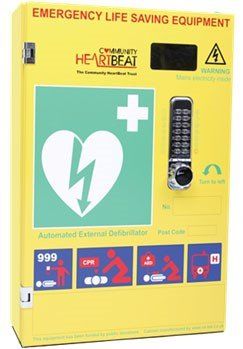Uley Defibrillators are located outside the Village Hall and the Pavilion at the Playing Field in Shadwell.
Same access code for both = C123X
How to save a life
If you find someone is unconscious, not breathing, or gurgling and turned a funny colour then:
1. Call 999
2. Start chest compressions (CPR)
3. Access the defibrillator (AED), code number C123X and follow verbal instructions from the Defibrillator
4. Send to hospital as quickly as possible
Defibrillators - How to Use Them
The government has a new non-statutory guidance document 'Automated External Defibrillators (AEDs)'. Evidently we, the public, often confuse the terms 'cardiac arrest' and 'heart attack' and as a result gave the impression that they are the same condition and defibrillators could be used in both situations. This is not the case: a cardiac arrest is not the same as a heart attack.
Here is a quote from the guidance:
An Automated External Defibrillator (AED or ‘defibrillator’) is a machine that is placed externally on the body and is used to give an electric shock when a person is in cardiac arrest i.e., when the heart suddenly stops pumping blood around the body.
Cardiac arrest
A cardiac arrest is a life-threatening emergency where a person’s heart has suddenly stopped pumping blood around the body. The person will be unconscious, unresponsive and will not be breathing normally or not breathing at all. It is essential to call 999 immediately for an ambulance.
Heart attack
A heart attack happens when a blood clot blocks an artery around the heart...[the person does] not usually lose consciousness and continue breathing. It is vital that you call an ambulance immediately as this is a life-threatening situation. If the person is still conscious, this means their heart is still beating and CPR and/or the use of a defibrillator is not appropriate.
A defibrillator is only appropriate when the heart has stopped beating. If the heart attack deteriorates to a cardiac arrest, then it is appropriate to start CPR and use a defibrillator.
The guidance document can be found here: https://assets.publishing.service.gov.uk/government/uploads/system/uploads/attachment_data/file/1130210/Automated_External_Defibrillators_Guidance_jan_23.pdf
